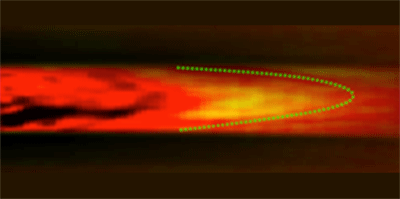November 13, 2013 report
Physicists devise a means for measuring blood flow inside the body

(Phys.org) —A team of researchers at Washington University in Missouri has developed a new and better way to measure blood flow as it moves through the body. In their paper published in the journal Physical Review Letters, the team describes how they combined two blood flow measuring techniques to come up with a third method that offers the best view yet of blood as it moves through veins, arteries and even capillaries.
Being able to monitor blood flow is critical for many medical applications, most particularly when trying to diagnose obstructions that can lead to heart attacks or stroke. Ideally, doctors would be able to put a patient under a machine that would allow them to see all of the blood flowing throughout the entire body. This new research appears to be a step in that direction.
Up until now, doctors have had to rely on one of two methods to detect blood flow in a patient. The first uses a form of Doppler ultrasound, and works as expected. Ultrasound signals are sent into the body and sensors listen for the Doppler effect that results as the sound is bounced back from blood moving closer to the sensor and then as it moves farther away again. The second method is called photoacoustic imaging and employs an infrared laser—blood beneath the skin is heated slightly causing a temporary pressure wave which can be detected by sensors. The first method only allows for fast moving blood and thus doesn't work with capillaries. The second method can't show blood moving as a continuous stream. In this new effort, the researchers combined the best features of the two methods to come up with something that is far superior to either.
In the new method, ultrasound is used to heat a small patch of blood—when pulsed it causes the creation of hot-spots—the hot spots can then be seen and followed using photoacoustic imaging in real time. This meant that the researchers were able to watch as a sample of cow blood moved through tubing that simulated actually veins. To better simulate real conditions, the researchers heated blood in the tubing through a 5mm thick piece of chicken breast tissue.
More testing will have to be done of course, to ensure the procedure doesn't cause any harm, but if things go as planned, doctors may very soon be able to watch blood as it flows through vital body parts, noting if anything is going wrong.
More information: Ultrasonically Encoded Photoacoustic Flowgraphy in Biological Tissue, Phys. Rev. Lett. 111, 204301 (2013)
Abstract
Blood flow speed is an important functional parameter. Doppler ultrasound flowmetry lacks sufficient sensitivity to slow blood flow (several to tens of millimeters per second) in deep tissue. To address this challenge, we developed ultrasonically encoded photoacoustic flowgraphy combining ultrasonic thermal tagging with photoacoustic imaging. Focused ultrasound generates a confined heat source in acoustically absorptive fluid. Thermal waves propagate with the flow and are directly visualized in pseudo color using photoacoustic computed tomography. The Doppler shift is employed to calculate the flow speed. This method requires only acoustic and optical absorption, and thus is applicable to continuous fluid. A blood flow speed as low as 0.24 mm·s-1 was successfully measured. Deep blood flow imaging was experimentally demonstrated under 5-mm-thick chicken breast tissue.
Journal information: Physical Review Letters
© 2013 Phys.org



















